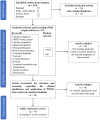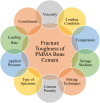Fracture Toughness of Acrylic PMMA Bone Cement: A Mini-Review
- PMID: 34824722
- PMCID: PMC8586281
- DOI: 10.1007/s43465-021-00495-2
Fracture Toughness of Acrylic PMMA Bone Cement: A Mini-Review
Abstract
Background: Acrylic PMMA bone cement is an essential component in cemented implants and formed the cement-bone and cement-implant interfaces. The information on the fracture parameters of PMMA bone cement would be decisive for all doctors, researchers, and orthopaedic surgeons.
Purpose: This review aims to indicate the parameters responsible for the variation in the fracture toughness of PMMA bone cement. This mini-review also points out some limitations of the earlier published research article, which can be added in the future analysis and can be helpful to get the more realistic data of the fracture parameters of PMMA bone cement.
Conclusion: Different mixing techniques, storage medium, temperature, loading conditions, frequency and environment, cement viscosity, type of specimen, and the ASTM standards (shape, size, and geometry), constituents, loading rate, and cement porosity were the critical parameters to affect the fracture toughness of PMMA bone cement. This study will also be helpful to increase the structural integrity of PMMA bone cement and the cemented implant.
Keywords: Cemented implants; Fatigue; Fracture toughness; Mechanical properties; Mixing techniques; PMMA bone cement; Porosity; Storage medium; Viscosity.
© Indian Orthopaedics Association 2021.
Conflict of interest statement
Conflict of InterestThe authors declare that they have no conflict of interest.
Figures
References
Publication types
LinkOut - more resources
Full Text Sources



